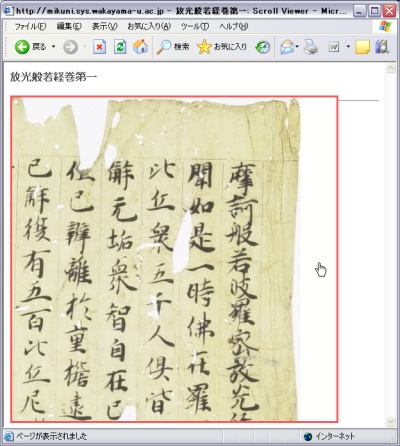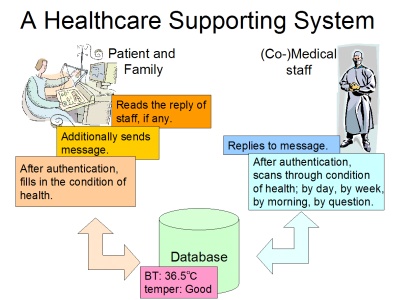Research Topics
Table of Contents
- Research Interests
- Information Processing for Buddhist Canons
- Database of Bibliography and Human Relationships in Japanese Buddhism
- Medical & Healthcare Supporting System
- Data Mining for Questionnaire
- Software Comprehension Support
- Database Systems
Research Interests [J]
keywords: data engineering, database system, Web application
I am engaged in education and research of information and communications technology, as a member of Data Engineering Research Group with Prof. Masaru Nakagawa, Dr. Takuya Yoshihiro, Dr. Etsuko Inoue, and academic students in the laboratory.
My activities center on designing, constructing, and operating the database systems that suit the users' needs. Continually I attend a meeting outside the university to find out about people's needs and to make them enjoy the resulting software with us!
In former times, I conducted the study of information security, especially cryptographic protocols. The problem consciousness of an early date was "how to describe the objects both to make them feasible using the computers and to bring the people happiness." This is still the same.
Information Processing for Buddhist Canons [J]
keywords: digital archive, reading support, image processing
There are a great number of Buddhist sutras many of which were transcribed several hundred ago, in the possession of temples in Japan. As the Buddhism was propagated from India to the east, the sutras translated in Chinese have been read, handwritten, run off, and distributed around East Asia such as China, Korea, and Japan.
To make use of the contents for Buddhist study and archeology, human researchers have ever visited famous temples such as Kongoji and Nanatsudera to take shot images of the sutras using digital cameras, by permission of the general managers. Those shot images are sometimes unreadable due to degradation, and then, one takes lots of trouble with combining the split, overlapping images.
We have been developing the image processing tools for eliminating redundant part of shot images, together with the viewer which enables us to read the seamless image of sutra.
The following picture is a screenshot of an earlier version of the viewer. After a drag-and-drag operation on the sutra indicated, the view is immediately and dynamically changed, just as looking at a map over Google Maps! A student improved the user interface through his graduation research in school year 2006, so that a text area can be displayed in conjunction with the image.

Database of Bibliography and Human Relationships in Japanese Buddhism [J]
keywords: digital archive, sutra database, database of individuals, full-text search
In the Middle Ages (8C-13C) of Japan, Buddhism was in full flourish; various denominations were established, elder noble people became Buddhist priests, lots of temples were set up, and Buddhist sutras were copied and stored in temples.
In those days the sutras were transcribed, because there was no printing technology. Then the colophons includes the origin of those documents. In fact, some colophons clearly state who directed, who and when handwrote, and where they were to be stored. These data help the humanities researchers investigate the human relationships and religious environment at that time.
There also exist historical materials on master-pupil relationship of priests, in the form of genealogical tables. Famous ones are put into print.
I collaborate with a humanities researcher and received enormous quality of computerized and non-computerized materials about genealogical tables of master-pupil relationships together with bibliographic data of sutras. Since the raw data are formatted in various ways (not only about file format such as Microsoft Access or Excel, but also about the table construction), we were obliged to make searching through every file separately.
To avoid the inconvenience, we have been constructing the database system which integrates those data to supply a single, user-friendly retrieving interface. Actually there were some prototypes developed which retrieve a priest and show the genealogical table with the priest on it. And then we adopt Hyper Estraier as the search engine to quickly retrieve sutra records including the characters we give.
We are now considering the database schema for the combination of human data and bibliographic records.
Medical & Healthcare Supporting System [J]
keywords: remote nursing-care support, health monitoring
Although Japanese "nursing-care insurance programs" began in 2000, support persons as well as medical staffs have not been free from the burden of the nursing-care. We would like to have in mind to take advantage of information and communication technology, by implementing and supplying database systems to get rid of the burden and to help them live a comfortable life.
We have actually constructed the healthcare supporting systems for aged people and for pediatric patients and their families. In these systems, the people in need of nursing care actively and regularly send the healthcare data while the medical personnel view them to make use of subsequent medical services or nursing-cares.
We promote this research project through a joint research with Wakayama Medical University, Wakayama Nursing Association and Wakayama Nursing Technical College. I am taking my share of the design and development of the database system, and of the data management during assessment experiments.

Throughout this development, we have proposed the "flash card" ("Tangocho" in Japanese) model to express daily health information in an intuitive, unifying way.
Data Mining for Questionnaire [J]
keywords: questionnaire support, statistical processing, discriminant analysis
There are so many questionnaire supporting systems for arranging questions effectively and for analyzing the answers from a variety of different angles.
We attempted to contribute to this field by providing questionnaire supporting systems for cerebral accident and for quality of working life. On cerebral accident, more than 700 replies throughout Wakayama Prefecture were broken down to find the risk factors, which confirm conventional findings of cerebral surgery.
Software Comprehension Support [J]
keywords: software engineering, idea creation support, SQL
When we would like to know if a program runs correctly or not, we may actually run it. If there are any syntax errors in it, the system will output the error messages before performing the code. In order to learn how long does it take for the run time with the code, all you have to do is prepare some sort of input.
By using those methods, though, we cannot make sure that the program is appropriate. For example, we would like to remove the redundant code although it is very difficult to detect such an unnecessary code automatically. The "code inspection" appear promising for this purpose, where one or more person reads the program codes carefully to help the programmers to improve them.
We have been trying to support the code inspection of SQL using the graphic record called the "clamshell diagram".
SQL is a programming language for the query to database. It is declarative, while on the other hand C or Java is procedural. As for the efficiency, a single, complicated SQL statement is prefer to divided, simplified statements. In addition, an SQL statement is often described as a string, embedded in a program written in another language like PHP; when we look at the code with a text editor, we do not obviously distinguish the SQL keywords from table names or column names. These properties convinced us the necessity of the code inspection of SQL.
A clamshell diagram is a graph which contains symmetrical double tree, derived from a "thinking process development diagram" which is devised with a view to the idea creation support. Each node has a piece of information which is used for the overall structure of the subject matter. An example (magnified by click):
When traversing the left-hand tree essentially in preorder, we have "SELECT title FROM ( SELECT MAX ( salary ) AS max_salary FROM joblist ) AS j , joblist WHERE salary = max_salary", which is a valid SQL statement. From the right-hand tree, "get title from " max of salary as max_salary from joblist " as j and joblist where salary is equal to max_salary" is derived. The query is to retrieve the titles of the maximum salary, under the assumption that there is a table named joblist which consists of two columns by the name of title and salary.
Clamshell diagrams tell us the configuration of the segmentalized pieces of information. The symmetrical property makes clear the relationship between the problem and solution.
We have developed the converter of SQL statements into clamshell diagrams. The converter is composed of several Ruby scripts, while a Ruby's library Racc is employed for parsing SQL statements and Graphviz for drawing the diagrams. Future works include the improvement of readability.
Database Systems [J]
keywords: Web application, database system, human centered design
I had engaged myself in the database systems of educational affairs, electronic commerce, and 3-D images for industrial design.
Not only the database design but also implementation were put in execution, in collaboration with staffs and students in our laboratory as well as target users who does not necessarily have good command of computers.


